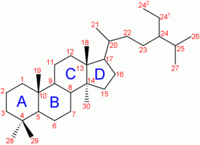



A ketosteroid, or an oxosteroid, is a steroid in which a hydrogen atom has been replaced with a ketone (C=O) group.
A 17-ketosteroid is a ketosteroid in which the ketone is located specifically at the C17 position (in the upper right corner of most structure diagrams).
Examples of 17-ketosteroids include:
- Androstenedione
- Androstanedione
- Androsterone
- Dehydroepiandrosterone
- Epiandrosterone
- Epietiocholanolone
- Etiocholanolone
17-Ketosteroids are endogenous steroid hormones.
See also
External links
- 17-Ketosteroids at the U.S. National Library of Medicine Medical Subject Headings (MeSH)
- MedlinePlus Encyclopedia: 003460








